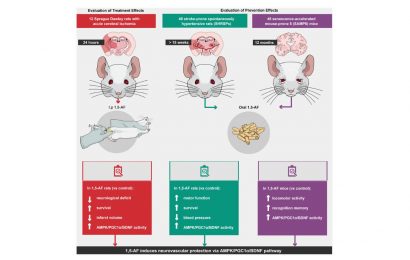Within and upon every human being reside countless microorganisms -; the microbiota that help shape and direct the lives of their hosts. A similar phenomenon occurs between people, microbes and the homes they share.
Writing in the June 24, 2022 issue of Science Advances, scientists at University of California San Diego School of Medicine and elsewhere report on the molecular impact of life indoors, describing how the presence of humans interacts with their microbial roommates, changing the home's biology and chemistry.
The findings, suggest the authors, should influence future building designs.
Modern Americans spend approximately 70 percent of their time inside, reshaping the indoor microbiome with inputs from their bodies. Limited research has investigated the interaction between humans and indoor exposures to specific pollutants, toxins and particles, but the new study more ambitiously documents how people influence the entire molecular and chemical composition of a home through routine activities.
An experimental test home was erected in Austin, Texas during the summer of 2018. The house was designed for ordinary use and included bathrooms, a kitchen, gathering and work areas. Overnight stays were prohibited, but 45 study participants, plus visitors, spent time in the house, occupying it for approximately six hours per day for 26 days, during which they performed scripted activities, such as cooking, cleaning and socializing.
Researchers sampled the distribution of detectable molecules and microbes throughout the occupied areas of the house at the beginning of the experiment, dubbed T1, and again 28 days later, dubbed T2, largely by swabbing surfaces and conducting different genomic, metabolic and chemical analyses.
Before T1, the house was deep cleaned with a bleach solution. Nonetheless, researchers said traces of molecules associated with humans were still present. At T2, after almost of month of human occupation, the house was alive with molecular and microbial abundance and diversity, albeit unevenly distributed.
Researchers found molecules associated with skin care products, skin cells, drugs (such as antidepressants and anabolic steroids), food-derived molecules (such as terpenes and flavonoids), human or animal metabolites (molecules generated during the process of metabolism, such as bile and fatty acids), amino acids, sugars and microbial metabolites.
Most of the indoor surface molecules were natural products (biologically produced molecules rather than synthetic compounds), food, molecules associated with the outdoors, personal care products and human-derived metabolites, often traced to fecal matter.
Food, human-associated microbes, feces, building materials and the microbes that grow upon them and building materials in humid conditions were deemed the likely primary sources.
Not surprisingly, the kitchen and toilet were hotspots of molecular and microbial diversity, though numbers fluctuated with surface cleaning and sanitation. "It appears that, even when a subset of chemistry is removed because of the cleaning, it is only temporary and/or partial, as the sum total of cleaning and human activities overall results in an increase in accumulation of richer chemistry," the authors wrote.
Surfaces routinely touched by people, such as tables, light switches and knobs, were more abundant in molecular and microbial chemistry. Floors showed less molecular diversity, perhaps because they were cleaned more often. Windows, chairs and doors not routinely touched by human occupants displayed the least change in chemical diversity between T1 and T2.
Other residents
Of course, people weren't the only occupants of the test home. Researchers found indoor surfaces covered with bacteria, fungi and other microbes, plus their metabolites. Regular cleaning altered these microbial populations and diversity over time, allowing different species to recolonize cleaned spaces.
At the end of the test period, less than half of the house's original microbiome remained, but it accounted from more than 96 percent of all microbial life counted. Most of the detected microbiome at T2 was derived from human occupants, mainly commensal species that reside on human skin or in the gut. Free-living, environment-associated microbes had been depleted by human activities. In other words, cleaned or pushed out.
We don't know exactly how the human-related microbes squeezed out the environmental microbes because there are many ways this could happen, but it's clear that they do. Understanding this phenomenon will be a key goal of future research on the microbiology of the built environment."
Rob Knight, PhD, one of the study's principal investigators and director of the Center for Microbiome Innovation at UC San Diego
The authors noted that at least 1 percent of the detected indoor molecules may pose an outsized health effect. For example, the bacterial species Paenibacillus was associated with molecules from coffee, one of the dominant sources of food-derived indoor molecules detected. In the home, especially at T2, Paenibacillus was observed in and around the area where coffee was prepared and the genus has been found to grow in coffee machines. Paenibacillus species have been used as probiotics in chickens and bees, and may also contribute to human health, consistent with recent reports that coffee drinking is associated with improved cardiovascular health and longevity.
"Understanding specifically how our observations that both human and microbial occupants change the chemical make-up of a home should influence building material design to improve human health will require additional studies," said co-principle investigator Pieter Dorrestein, PhD, director of the Collaborative Mass Spectrometry Innovation Center at Skaggs School of Pharmacy and Pharmaceutical Sciences at UC San Diego.
University of California – San Diego
Aksenov, A.A., et al. (2022) The molecular impact of life in an indoor environment. Science Advances. doi.org/10.1126/sciadv.abn8016.
Posted in: Life Sciences News | Biochemistry
Tags: Anabolic Steroids, Bacteria, Bile, Coffee, Drugs, Fatty Acids, Food, fungi, Genomic, Mass Spectrometry, Medicine, Metabolism, Metabolites, Microbiology, Microbiome, Petri Dish, Pharmacy, Probiotics, Research, Skin, Skin Cells, Spectrometry, Terpenes, Toxins
Source: Read Full Article


